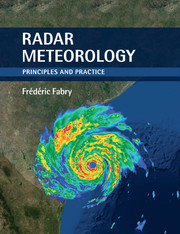Book contents
- Frontmatter
- Dedication
- Contents
- Preface
- Notation
- 1 Meteorology and radar
- 2 Fundamentals of weather radar measurements
- 3 Radar reflectivity and products
- 4 Reflectivity patterns
- 5 Doppler velocity information
- 6 The added value of dual polarization
- 7 Convective storm surveillance
- 8 Monitoring widespread systems
- 9 Radar estimation of precipitation
- 10 Nowcasting
- 11 Additional radar measurements and retrievals
- 12 Cloud and spaceborne radars
- 13 What does radar really measure?
- Appendix A Mathematics and statistics of radar meteorology
- References
- Index
11 - Additional radar measurements and retrievals
Published online by Cambridge University Press: 05 June 2015
- Frontmatter
- Dedication
- Contents
- Preface
- Notation
- 1 Meteorology and radar
- 2 Fundamentals of weather radar measurements
- 3 Radar reflectivity and products
- 4 Reflectivity patterns
- 5 Doppler velocity information
- 6 The added value of dual polarization
- 7 Convective storm surveillance
- 8 Monitoring widespread systems
- 9 Radar estimation of precipitation
- 10 Nowcasting
- 11 Additional radar measurements and retrievals
- 12 Cloud and spaceborne radars
- 13 What does radar really measure?
- Appendix A Mathematics and statistics of radar meteorology
- References
- Index
Summary
The data provided by reflectivity, radial velocity, and multiple polarization measurements are extremely valuable. However, particularly in research applications, additional information about unobserved fields or data quality would be needed to better interpret radar data, understand weather phenomena, and forecast them: What are the tangential components of the wind? How are the pressure, temperature, or humidity fields? To what extent are the radar data affected by attenuation or non-Rayleigh scattering? Many of those questions cannot be answered by radar. But some can, either by combining information from multiple radars or by processing radar data in unusual ways. In this chapter, the concepts behind a few of these approaches will be introduced.
Using multiple viewing angles
One of the key limitations of radar data is that only one of the three wind components can be measured. A solution to this problem is to combine existing measurements with those from another radar, or at least from another viewing angle. Once a second wind component is measured, the third can be derived, as will be seen at the end of this section.
Analyses of winds made by multiple Doppler radars rely on having measurements from at least two partially independent components of the wind (Fig. 11.1). Ideally, one would want to measure two horizontal wind components 90° apart to be able to simply derive the u (east – west) and v (north–south) component of the wind. In practice, this can be achieved even if two components are not 90° apart, as long as they are sufficiently different. Most researchers consider that the two components must be at least 30° apart so that measurement errors on each component do not compromise the quality of the retrieved tangential component; in that scenario, the area over which an adequate dual-Doppler wind analysis can be made forms two lobes on either side of the baseline between the two radars, as illustrated in Fig. 11.1. Increasing the baseline distance enlarges the analysis area but reduces its resolution as well as limits the ability to obtain winds at the lowest levels.
- Type
- Chapter
- Information
- Radar MeteorologyPrinciples and Practice, pp. 180 - 188Publisher: Cambridge University PressPrint publication year: 2015



